Stånga
Stånga
Stangge(Gutnish) | |
|---|---|
 Stånga Church | |
| Coordinates: 57°16′53″N 18°28′17″E / 57.28139°N 18.47139°E | |
| Country | Sweden |
| Province | Gotland |
| County | Gotland County |
| Municipality | Gotland Municipality |
| Area | |
| • Total | 1.05 km2 (0.41 sq mi) |
| Time zone | UTC+1 (CET) |
| • Summer (DST) | UTC+2 (CEST) |
Stånga is a locality on the Swedish island of Gotland, with 491 inhabitants in 2014.[2]
Stånga is also the name of the larger populated area, socken (not to be confused with parish).[3] It comprises the same area as the administrative Stånga District, established on 1 January 2016.[4]
Stånga is most noted for hosting the annual Stånga Games (Swedish: Stångaspelen).
Geography[edit]
Stånga is the name of the locality surrounding the medieval Stånga Church,[5] sometimes referred to as Stånga kyrkby. It is also the name of the socken as well as the district. Stånga is located in the southeast part of Gotland.[6]
As of 2019[update], Stånga Church belongs to Stånga-Burs parish in Burs pastorat, along with the church in Burs.[7][8]
One of the asteroids in the asteroid belt, 10131 Stånga, is named after this place.[9]
Stånga Games[edit]

The Stånga Games (Stångaspelen), also referred to as the "Gotland Olympic Games", is an annual sports competition in Stånga. The first games were concluded on 27 July 1924. The games are held during five days around the second weekend in July and gathers about 2000 participants. Competitions are held in various Gutnish disciplines, some dating back to the Viking Age.[10] The sports include Varpa, Pärk, Caber toss, Gutnish pentathlon, Pillow fight on a pole (Herre på stång), Leg hook (Rövkrok), Hobble kick (Sparka Bleistre), Tug of war, eight-man teams (Dragkamp), Two-men tug of war, facing (Att dra hank), Two-men tug of war, back to back (Att täme stäut) etc.
References[edit]
- ^ "Tätorternas landareal, folkmängd och invånare per km2 2005 och 2010" (in Swedish). Statistics Sweden. 14 December 2011. Archived from the original on 27 January 2012. Retrieved 10 January 2012.
- ^ a b "Gotland i siffror 2015" [Gotland in numbers 2015]. www.gotland.se. Gotland Municipality. Retrieved 25 May 2016.
- ^ The exact extent of the socken, now district, can be obtained by clicking on Kartinställningar and check the Socken box in the menu of this map from the Swedish National Heritage Board database.
- ^ "Förordning om district" [Regulation of districts] (PDF). Ministry of Finance. 17 June 2015. Retrieved 25 May 2016.
- ^ Lagerlöf, Erland; Svahnström, Gunnar (1973). Gotlands kyrkor [Gotland's Churches] (in Swedish). Stockholm: Rabén & Sjögren. pp. 245–248. ISBN 91-29-41035-5. SELIBR 7232718.
- ^ "Stånga". www.ne.se. Nationalencyklopedin. Retrieved 31 May 2016.
- ^ "Församlingar på Gotland". www.svenskakyrkan.se. Church of Sweden. Retrieved 12 January 2019.
- ^ "Visby stifts indelning 2018". www.svenskakyrkan.se. Church of Sweden. Retrieved 12 January 2019.
- ^ "10131 Stanga (1993 FP73)". NASA. Retrieved 24 June 2016.
- ^ Molin, Maria (12 June 2015). "Stångaspelen för den oinvigde" [Stånga Games for the uninitiated]. www.gotland.net. Gotlands Media AB. Retrieved 24 June 2016.
External links[edit]
 Media related to Stånga at Wikimedia Commons
Media related to Stånga at Wikimedia Commons- Objects from Stånga at the Digital Museum by Nordic Museum


